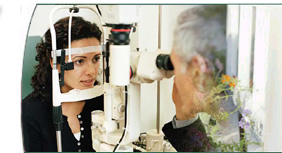|
Oculoplasty
What
is Oculoplasty?
This is the subject which deals with plastic surgery and reconstruction
of eyes and related parts of the eye along with the face in cases
where the problem is by birth or acquired.
Facilities
| |
|
| |
|
|
|
| |
|
|
 |
| |
|
|
|
|
|
| Entropion
and Ectropion
(lid abnormalities)
Entropion
is a disorder of eyelids causing in turning of lid margin.
This condition is caused by scarring of tarsus and conjunctiva.
Common
causes
-
Trachoma
-
Chemical/Thermal Burns
-
Infectious diseases
-
Herpes zoster
-
Lid trauma and surgery
|
Techniques
- Skin
muscle excision
-
Wedge resection
-
Tarsal fracture (tarsotomy with tarsal rotation).
-
Jones procedure
-
Full thickness blepharotomy and tarsal rotation (Wies technique)
-
Mucous membrane grafting with anterior lamellar repositioning.
-
Posterior lamellar eyelid reconstruction using:
a. Hard palatal mucosa
b. Auricular cartilage
c. Nasal septal cartilage
d.
Banked sclera
|
Ptosis
 |
Ptosis
means drooping of eyelids. It predominantly occurs in upper
lid and is mostly congenital in nature. It is the result
of the weakness or paralysis of levator or muller’s
muscle (the muscle which elevates the upper eye lid). Management
of the condition requires a thorough understanding of the
surgical anatomy and a meticulous surgical technique based
on a proper evaluation. It is associated with various anomalies.
It can be congenital or acquired. |
Functions
of lid
Reflex closure of the eye - protects the eye ball (loud noise, glare,
flying foreign object)
Prevents cornea from dryness, (Keeps the cornea wet and moist).
Blinking keeps cornea moist and warm.
Cilia mainly of upper lid protect the eye from flying objects.
Any
disorder that disturbs the upper lid anatomy and physiology becomes
not only a cosmetic blemish, but a serious physiologic impediment
requiring correction.
Preoperative
Examination :
This is the most important step in the treatment of Ptosis. The
choice of surgery and degree of correction to be carried out at
time of surgery depends on this.
History
-
Age of onset
-
Improvement / Worsening
-
Trauma / birth injury
-
Family history
-
Previous surgery
Examination
Bilaterality (Involvement of both eyes)
Degree
of Ptosis
In
case of unilateral Ptosis, the difference in aperture in primary
position. In case of bilateral Ptosis, the relation lid margin to
the limbus & pupil in the primary position.
-
Mild Ptosis 2mm or less
-
Moderate Ptosis of 3mm
-
Severe Ptosis of 4mm or more.
Surgery
It is done to elevate the upper eye in relation to the normal eyelid.
Depending
upon
Whether the Ptosis is unilateral or bilateral
Severity of Ptosis
Levator muscle action
Procedures : Broadly it is divided into
-
Sling procedures (brow suspension with fascia lata) ; in cases
of poor LPS action special material is used to elevate the eye
lid.
Fasanella Servat Operation
-
Levator muscle resection : shortening of the LPS muscle to elevate
the eye lid.
-
In complicated cases many other procedures are done, when associated
abnormalities are present. Presence of associated problems of
ocular motility like squint, Blepharophimosis syndrome or jaw
winking phenomena.
Post-Operative
care :
- Broad spectrum
antibiotics and anti-inflammatory drugs are given for five days.
- Local hot
fermentation for one week if required.
- Cornea is
kept moist with lubricant and antibiotics ointment day and night.
- Frost suture
is kept for 3-4 days depending on circumstances.
- Local
hygiene is maintained by keeping the wound clean by daily clearing
with wetswab stick and betadine application.
- Stitches
are removed after 5 days.
|











